Ernest King
| Ernest King | |
|---|---|
 Fleet Admiral Ernest J. King, USN | |
| Nickname(s) |
"Ernie" "Rey" |
| Born |
23 November 1878 Lorain, Ohio |
| Died |
25 June 1956 (aged 77) Kittery, Maine |
| Buried | United States Naval Academy Cemetery |
| Allegiance | United States |
| Service/ | United States Navy |
| Years of service | 1901–1956[1] |
| Rank | Fleet Admiral |
| Commands held |
Chief of Naval Operations United States Fleet United States Atlantic Fleet USS Lexington Naval Station Norfolk USS Wright USS Bridge Naval Postgraduate School USS Terry |
| Battles/wars |
Spanish–American War |
| Awards |
Navy Cross Navy Distinguished Service Medal (3) |
| Other work | President, Naval Historical Foundation |
Ernest Joseph King (23 November 1878 – 25 June 1956) was Commander in Chief, United States Fleet (COMINCH) and Chief of Naval Operations (CNO) during World War II. As COMINCH-CNO, he directed the United States Navy's operations, planning, and administration and was a member of the Joint Chiefs of Staff. He was the United States Navy's second most senior officer in World War II after Fleet Admiral William D. Leahy, who served as Chief of Staff to the Commander in Chief.
Born in Lorain, Ohio, King served in the Spanish–American War while still attending the United States Naval Academy. He received his first command in 1914, leading the destroyer USS Terry in the occupation of Veracruz. During World War I, he served on the staff of Vice Admiral Henry T. Mayo, the commander of the United States Atlantic Fleet. After the war, King served as head of the Naval Postgraduate School, commanded a submarine squadron, and served as Chief of the Bureau of Aeronautics. After a period on the Navy's General Board, King became commander of the Atlantic Fleet in February 1941.
Shortly after the Japanese attack on Pearl Harbor brought the United States into World War II, King was appointed as Commander in Chief of the United States Fleet. In March 1942, King succeeded Harold Stark as Chief of Naval Operations. In December 1944, King became the second admiral to be promoted to fleet admiral. King left active duty in December 1945 and died in 1956.
Early life
King was born in Lorain, Ohio, on 23 November 1878, the son of James Clydesdale King and Elizabeth Keam King.[2] He attended the United States Naval Academy from 1897 until 1901, graduating fourth in his class. During his senior year at the academy, he attained the rank of midshipman lieutenant commander, the highest midshipman ranking at that time.[3]
Surface ships
While still at the Naval Academy, King served on the cruiser USS San Francisco during the Spanish–American War. After graduation, he served as a junior officer on the survey ship USS Eagle, the battleships USS Illinois, USS Alabama and USS New Hampshire, and the cruiser USS Cincinnati.[4]
King returned to shore duty at Annapolis in 1912. He received his first command, the destroyer USS Terry in 1914, participating in the United States occupation of Veracruz.[5] He then moved on to a more modern destroyer, USS Cassin.
During World War I, King served on the staff of Vice Admiral Henry T. Mayo, the Commander in Chief, Atlantic Fleet. As such, he was a frequent visitor to the Royal Navy and occasionally saw action as an observer on board British ships. It appears that his Anglophobia developed during this period,[6] although the reasons are unclear. He was awarded the Navy Cross "for distinguished service in the line of his profession as assistant chief of staff of the Atlantic Fleet."[7] It was after World War I that King affected his signature manner of wearing his uniform, with a breast-pocket handkerchief under his ribbons (see image, top right). Officers serving alongside the Royal Navy did this in emulation of Admiral David Beatty. King was the last to continue this tradition.[8]
After the war, King, now a captain, became head of the Naval Postgraduate School. Along with Captains Dudley Wright Knox and William S. Pye, King prepared a report on naval training that recommended changes to naval training and career paths. Most of the report's recommendations were accepted and became policy.[9]
Submarines
Before World War II, King served in the surface fleet. From 1923 to 1925, he held several posts associated with submarines. As a junior captain, the best sea command he was able to secure in 1921 was the stores ship USS Bridge. The relatively new submarine force offered the prospect of advancement.[10]
King attended a short training course at the Naval Submarine Base New London before taking command of a submarine division, flying his commodore's pennant from USS S-20. He never earned his Submarine Warfare insignia (dolphins), although he did propose and design the now-familiar dolphin insignia. In 1923, he took over command of the Submarine Base itself.[11] During this period, he directed the salvage of USS S-51, earning the first of his three Navy Distinguished Service Medals.
Aviation
In 1926, Rear Admiral William A. Moffett, Chief of the Bureau of Aeronautics (BuAer), asked King if he would consider a transfer to naval aviation. King accepted the offer and took command of the aircraft tender USS Wright with additional duties as senior aide on the staff of Commander, Air Squadrons, Atlantic Fleet.[12]
That year, the United States Congress passed a law (10 USC Sec. 5942) requiring commanders of all aircraft carriers, seaplane tenders, and aviation shore establishments be qualified naval aviators or naval aviation observers. King therefore reported to Naval Air Station Pensacola, Florida, for aviator training in January 1927. He was the only captain in his class of twenty, which also included Commander Richmond K. Turner. King received his wings as Naval Aviator No. 3368 on 26 May 1927 and resumed command of Wright. For a time, he frequently flew solo, flying down to Annapolis for weekend visits to his family, but his solo flying was cut short by a naval regulation prohibiting solo flights for aviators aged 50 or over.[13] However, the history chair at the Naval Academy from 1971 to 1976 disputes this assertion, stating that after King soloed, he never flew alone again.[14] His biographer described his flying ability as "erratic" and quoted the commander of the squadron with which he flew as asking him if he "knew enough to be scared?"[15] Between 1926 and 1936 he flew an average of 150 hours annually.[16]
King commanded Wright until 1929, except for a brief interlude overseeing the salvage of USS S-4. He then became Assistant Chief of the Bureau of Aeronautics under Moffett. The two fell out over certain elements of Bureau policy, and he was replaced by Commander John Henry Towers and transferred to command of Naval Station Norfolk.[17]
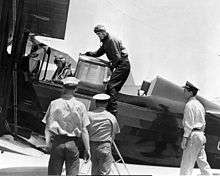
On 20 June 1930, King became captain of the carrier USS Lexington—then one of the largest aircraft carriers in the world—which he commanded for the next two years.[18] During his tenure aboard the Lexington, King was the commanding officer of notable science fiction author Robert A. Heinlein, then Ensign Heinlein, prior to his medical retirement from the US Navy. During that time, Ensign Heinlein dated one of King's daughters.[19]
In 1932, King attended the Naval War College. In a war college thesis entitled "The Influence of National Policy on Strategy", King expounded on the theory that America's weakness was Representative democracy:
Historically ... it is traditional and habitual for us to be inadequately prepared. This is the combined result of a number factors, the character of which is only indicated: democracy, which tends to make everyone believe that he knows it all; the preponderance (inherent in democracy) of people whose real interest is in their own welfare as individuals; the glorification of our own victories in war and the corresponding ignorance of our defeats (and disgraces) and of their basic causes; the inability of the average individual (the man in the street) to understand the cause and effect not only in foreign but domestic affairs, as well as his lack of interest in such matters. Added to these elements is the manner in which our representative (republican) form of government has developed as to put a premium on mediocrity and to emphasise the defects of the electorate already mentioned.[20]
Following the death of Admiral Moffet in the crash of the airship USS Akron on 4 April 1933, King became Chief of the Bureau of Aeronautics, and was promoted to rear admiral on 26 April 1933.[21] As bureau chief, King worked closely with the chief of the Bureau of Navigation, Rear Admiral William D. Leahy, to increase the number of naval aviators.[22]
At the conclusion of his term as bureau chief in 1936, King became Commander, Aircraft, Base Force, at Naval Air Station North Island, California.[23] He was promoted to vice admiral on 29 January 1938 on becoming Commander, Aircraft, Battle Force – at the time one of only three vice admiral billets in the US Navy.[24] Among his accomplishments was to corroborate Admiral Harry E. Yarnell's 1932 war game findings in 1938 by staging his own successful simulated naval air raid on Pearl Harbor, showing that the base was dangerously vulnerable to aerial attack, although he was taken no more seriously than his contemporary until December 7, 1941 when the Imperial Japanese Navy attacked the base by air for real.[25]
King hoped to be appointed as either Chief of Naval Operations or Commander in Chief, United States Fleet, but on 15 June 1939, he was posted to the General Board, an elephants' graveyard where senior officers spent the time remaining before retirement. A series of extraordinary events would alter this outcome.[26]
World War II
King's career was resurrected by his friend, Admiral Harold "Betty" Stark, the Chief of Naval Operations (CNO) who realized King's talent for command was being wasted on the General Board. Stark appointed him Commander, Atlantic Squadron, in 1940. King was promoted to admiral in February 1941 as Commander in Chief, Atlantic Fleet (CINCLANT). On 30 December, he became Commander in Chief, United States Fleet (COMINCH). (Admiral Husband Kimmel held this position during the attack on Pearl Harbor.)[27] On 18 March 1942, King was appointed CNO, relieving Stark, becoming the only officer to hold this combined command. After turning 64 on 23 November 1942, he wrote President Franklin D. Roosevelt to say he had reached mandatory retirement age. Roosevelt replied with a note reading, "So what, old top?".[28]
Historian Michael Gannon blamed King for the heavy American losses during the Second Happy Time. Others however blamed the belated institution of a convoy system, partly due to a severe shortage of suitable escort vessels, without which convoys were seen as more vulnerable than lone ships.[29]
On 17 December 1944, King was promoted to the newly created rank of fleet admiral, the second of four men in the U.S. Navy to hold that rank during World War II. He left active duty on 15 December 1945, but officially remained in the Navy, as five-star officers were to be given active duty pay for life. On the same day that King left active duty, Fleet Admiral Chester Nimitz succeeded him as Chief of Naval Operations.
Retirement and death
After retiring, King lived in Washington, D.C.. He was active in his early post-retirement, serving as president of the Naval Historical Foundation from 1946 to 1949, and he wrote the foreword to and assisted in the writing of Battle Stations! Your Navy In Action, a photographic history book depicting the U.S. Navy's operations in World War II that was published in 1946. King suffered a debilitating stroke in 1947, and subsequent ill-health ultimately forced him to stay in naval hospitals at Bethesda, Maryland, and at the Portsmouth Naval Shipyard in Kittery, Maine. King briefly served as an advisor to the Secretary of the Navy in 1950, but he was unable to return to duty in any long-term capacity as his health would not permit it. King wrote an autobiography, Fleet Admiral King: A Naval Record, which he published in 1952.
King died of a heart attack in Kittery on 25 June 1956, at the age of 77.[30] After lying in state at the National Cathedral in Washington, King was buried in the United States Naval Academy Cemetery at Annapolis, Maryland. His wife, who survived him, was buried beside her husband in 1969.
Analysis
Ernest King served 55 years on active duty in the United States Navy, one of the longest careers on record for that service. King is the only man to have ever held the posts of Chief of Naval Operations and Commander in Chief, United States Fleet simultaneously, making him one of the most powerful U.S. Navy officers ever to serve. As a naval officer, King was highly intelligent and extremely capable, but controversial and difficult to serve with, over, or under. King's blunt honesty and his short temper made him numerous enemies, leaving a mixed legacy.
Pointing to King's five-and-a-half decades in the Navy and his many accomplishments as one of the highest-ranked Allied military leaders of World War II, some consider King one of the greatest admirals of the 20th century;[31] others, however, point out he never commanded ships or fleets at sea in war time, and that his Anglophobia led him to make decisions which cost many Allied lives.[32]
Others see his ability to counter both British and U.S. Army influence on American World War II strategy as indicative of strong leadership, and praise his sometimes outspoken recognition of the strategic importance of the Pacific War.[31] His instrumental role in the decisive Guadalcanal Campaign has earned him admirers in the United States and Australia, and some consider him an organizational genius.[33] He was demanding and authoritarian, and could be abrasive and abusive to subordinates. King was widely respected for his ability, but not liked by many of the officers he commanded.
John Ray Stakes described him as:
... perhaps the most disliked Allied leader of World War II. Only British Field Marshal Montgomery may have had more enemies ... King also loved parties and often drank to excess. Apparently, he reserved his charm for the wives of fellow naval officers. On the job, he "seemed always to be angry or annoyed."[34]
There was a famous tongue-in-cheek remark about King, made by one of his daughters and repeated by Navy personnel at the time, that "he is the most even-tempered person in the United States Navy. He is always in a rage." Franklin D. Roosevelt once described King as a man who "shaves every morning with a blow torch."[35]
It is commonly reported when King was called to be COMINCH, he remarked, "When they get in trouble they send for the sons-of-bitches." However, when he was later asked if he had said this, King replied he had not, but would have if he had thought of it.[36] On the other hand, King's view of press relations for the US Navy in World War II is well documented. When asked to state a public relations policy for the Navy, King replied "Don't tell them anything. When it's over, tell them who won."[37]
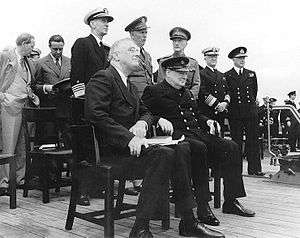
Response to Operation Drumbeat
At the start of US involvement in World War II, blackouts on the U.S. eastern seaboard were not in effect, and commercial ships traveling the coastal waterways were not travelling under convoy. King's critics attribute the delay in implementing these measures to his Anglophobia, as the convoys and seaboard blackouts were British proposals, and King was supposedly loath to have his much-beloved U.S. Navy adopt any ideas from the Royal Navy. He also refused, until March 1942, the loan of British convoy escorts when the Americans had only a handful of suitable vessels. He was, however, aggressive in driving his destroyer captains to attack U-boats in defense of convoys and in planning counter-measures against German surface raiders, even before the formal declaration of war in December 1941.[38]
Instead of convoys, King had the U.S. Navy and U.S. Coast Guard perform regular anti-submarine patrols, but these patrols followed a regular schedule. U-boat commanders learned the schedule, and coordinated their attacks to these schedules. Leaving the lights on in coastal towns back-lit merchant ships for the U-Boats. As a result, there was a period of disastrous shipping losses—two million tons lost in January and February 1942 alone, and urgent pressure applied from both sides of the Atlantic. However, King resisted the use of convoys because he was convinced the Navy lacked sufficient escort vessels to make them effective. The formation of convoys with inadequate escort would also result in increased port-to-port time, giving the enemy concentrated groups of targets rather than single ships proceeding independently. Furthermore, blackouts were a politically sensitive issue—coastal cities resisted, citing the loss of tourism revenue.
It was not until May 1942 that King marshalled resources—small cutters and private vessels that he had previously scorned—to establish a day-and-night interlocking convoy system running from Newport, Rhode Island, to Key West, Florida.[39]
By August 1942, the submarine threat to shipping in U.S. coastal waters had been contained. The U-boats' "second happy time" ended, with the loss of seven U-boats and a dramatic reduction in shipping losses. The same effect occurred when convoys were extended to the Caribbean. Despite the ultimate defeat of the U-boat, some of King's initial decisions in this theatre could be viewed as flawed.[40]
As to escort carriers, two following the general design of USS Long Island (acquired March 1941) were built prior to December 1941 with one being siphoned-off by the UK. During the first half of 1942, four CVE's were commissioned with two going to the UK with the other two being assigned to the US Navy with one each to the Pacific and Atlantic. In the last half of 1942, fifteen CVE's were commissioned with six going to the UK, and all but one of the US Navy units initially assigned to the Atlantic Fleet. The US manned CVE's carried a more robust air wing the previous UK-built/manned vessels and, obviously, the UK units were not assigned to the daunting tasks facing the US Navy.
By June 25, 1942, the US Navy had 168 "primary" patrol aircraft in the "Battle for the Atlantic" zones in 15 squadrons while 176 aircraft (including the remainder of the US Asiatic Squadrons) in the greater Pacific. The US Navy assigned 148 in-shore patrol aircraft in the Atlantic Fleet while 86 were assigned in the Greater Pacific. By December 8, 1942, the US Navy increased the "primary" patrol aircraft to 174 in the Atlantic with a net of 164 in the Pacific (net of headquarters and training commands and squadrons being trained). Actually, the US Atlantic Fleet training commands which conducted anti-submarine and convoy escort missions had more aircraft than the Pacific units.
There is no statistical evidence Admiral King stripped the Atlantic Fleet to fill the gaps in the Pacific nor is the evidence the US Navy had neglected the preparation for anti-submarine warfare or ignored the learning from WWI, the Neutrality Patrols or the early Battle of the Atlantic. The attack on Pearl Harbor caught the US Navy in the early stages of operationalization. One can praise the US Navy for its ability to implement convoys so quickly with a bevy of essentially "green" crews, new vessels and new aircraft coming "on line." If the war had started six months later the Germans would have been facing a very different US Navy.
A lesser leader could have pointed to the intense commitment to the Atlantic convoys system to the UK and Russia; augment the British Home Fleet; and/or support Australia and New Zealand (as the British Navy had) and would have demanded relocation of experienced crews and vessels back to US waters (as well as fought to eliminate any further lead-lease deployment of naval escort-grade vessels). Admiral King stayed the course and the US Navy reasserted itself both in the "Battle of the Atlantic" and, with no help from the British, in a string of great victories in the Pacific. The bottom line is if FDR thought Admiral King was incompetent Admiral King would have been fired.
Other decisions
Other decisions widely regarded as questionable were his resistance to the employment of long-range USAAF B-24 Liberator on Atlantic maritime patrols (thus allowing the U-boats a safe area in the middle of the Atlantic — the "Atlantic Gap")(see "INTER-SERVICE CHALLENGES" as well as the fact of the 13 PB4Y Naval Aviation Squadrons commissioned in 1943, 8 were initially deployed to the Atlantic Fleet), the denial of adequate numbers of landing craft to the Allied invasion of Europe (a very broad assertion since the US war production was in civilian hands and the Joint Chiefs recommended to the President the deployment priorities as well as the fact of the added drain on landing craft caused by Battle of Anzio), and the reluctance to permit the Royal Navy's Pacific Fleet any role in the Pacific (again, a broad assertion which has been treated in depth in a variety of recent histories of the War in the Pacific pointing to the complexities of integrating a British naval force which did not have an adequate supply infrastructure nor proven ability to operate with the US Navy's Fast Carrier groups). In all of these instances, circumstances forced a re-evaluation or he was overruled. It has also been pointed out that King did not, in his post-war report to the Secretary of the Navy, accurately describe the slowness of the American response to the off-shore U-boat threat in early 1942.[41]
It should be noted, however, employment of long-range maritime patrol aircraft in the Atlantic was complicated by inter-service squabbling over command and control (the aircraft belonged to the Army; the mission was the Navy's; Secretary of War Stimson and General Arnold initially refused to release the aircraft).[42] This was later mitigated later in 1942 and into 1943 by the assignment of Navy-owned and operated PB4Y-1 Liberators, and by late 1944, the PB4Y-2 Privateer aircraft. Although King had certainly used the allocation of ships to the European Theatre as leverage to get the necessary resources for his Pacific objectives, he provided (at General Marshall's request) an additional month's production of landing craft to support Operation Overlord. Moreover, the priority for landing craft construction was changed, a factor outside King's remit. The level of sea lift for Overlord turned out to be more than adequate.
The employment of British and Empire forces in the Pacific was a political matter. The measure was forced on Churchill by the British Chiefs of Staff, not only to re-establish British presence in the region, but to mitigate any impression in the U.S. that the British were doing nothing to help defeat Japan. King was adamant that naval operations against Japan remain 100% American, and angrily resisted the idea of a British naval presence in the Pacific at the Quadrant Conference in late 1944, citing (among other things) the difficulty of supplying additional naval forces in the theatre (for much the same reason, Hap Arnold resisted the offer of RAF units in the Pacific). In addition, King (along with Marshall) had continually resisted operations that would assist the British agenda in reclaiming or maintaining any part of her pre-war colonial holdings in the Pacific or the Eastern Mediterranean. Roosevelt, however, overruled him and, despite King's reservations, the British Pacific Fleet accounted itself well against Japan in the last months of the war.[43]
General Hastings Ismay, chief of staff to Winston Churchill, described King as:[44]
... tough as nails and carried himself as stiffly as a poker. He was blunt and stand-offish, almost to the point of rudeness. At the start, he was intolerant and suspicious of all things British, especially the Royal Navy; but he was almost equally intolerant and suspicious of the American Army. War against Japan was the problem to which he had devoted the study of a lifetime, and he resented the idea of American resources being used for any other purpose than to destroy the Japanese. He mistrusted Churchill's powers of advocacy, and was apprehensive that he would wheedle President Roosevelt into neglecting the war in the Pacific.
Contrary to British opinion, King was a strong believer in the Germany first strategy. However, his natural aggression did not permit him to leave resources idle in the Atlantic that could be utilized in the Pacific, especially when "it was doubtful when — if ever — the British would consent to a cross-Channel operation".[45] King once complained that the Pacific deserved 30% of Allied resources but was getting only 15%. When, at the Casablanca Conference, he was accused by Field-Marshal Sir Alan Brooke of favoring the Pacific war, the argument became heated. The combative General Joseph Stilwell wrote: "Brooke got nasty, and King got good and sore. King almost climbed over the table at Brooke. God, he was mad. I wished he had socked him."[46]
Following Japan's defeat at the Battle of Midway, King advocated (with Roosevelt's tacit consent) the invasion of Guadalcanal. When General Marshall resisted this line of action (as well as who would command the operation), King stated the Navy (and Marines) would then carry out the operation by themselves, and instructed Admiral Nimitz to proceed with preliminary planning. King eventually won the argument, and the invasion went ahead with the backing of the Joint Chiefs. It was ultimately successful, and was the first time the Japanese lost ground during the war. For his attention to the Pacific Theatre he is highly regarded by some Australian war historians.[47]
In spite of (or perhaps partly because of) the fact the two men did not get along,[48] the combined influence of King and General Douglas MacArthur increased the allocation of resources to the Pacific War.[49]
Court-martial of Charles B. McVay III
Another controversy involving King was his role in the later annulled court-martial of Captain Charles B. McVay III, commander of USS Indianapolis, possibly as retaliation for being reprimanded by McVay's father much earlier.[50]
Personal life
While at the Naval Academy, King met Martha Rankin ("Mattie") Egerton, a Baltimore socialite, whom he married in a ceremony at the Naval Academy Chapel on 10 October 1905.[51] They had six daughters, Claire, Elizabeth, Florence, Martha, Eleanor and Mildred; and then a son, Ernest Joseph King, Jr. (Commander, USN ret.).[52]
Dates of rank
- Midshipman – June 1901
| Ensign | Lieutenant (junior grade) | Lieutenant | Lieutenant Commander | Commander | Captain |
|---|---|---|---|---|---|
| O-1 | O-2 | O-3 | O-4 | O-5 | O-6 |
 |
 |
 |
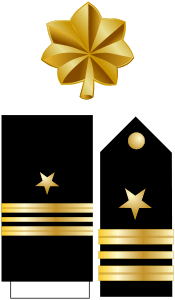 |
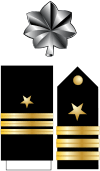 |
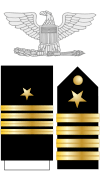 |
| 7 June 1903 | Never Held | 7 June 1906 | 1 July 1913 | 1 July 1917 | 21 September 1918 |
| Rear Admiral (lower half) | Rear Admiral | Vice Admiral | Admiral | Fleet Admiral |
|---|---|---|---|---|
| O-7 | O-8 | O-9 | O-10 | O-11 |
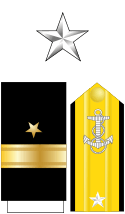 |
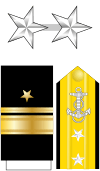 |
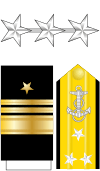 |
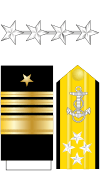 |
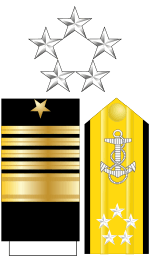 |
| Never Held | 26 April 1933 | 29 January 1938 | 1 February 1941 | 17 December 1944 |
King never held the rank of lieutenant (junior grade) although, for administrative reasons, his service record annotates his promotion to both lieutenant (junior grade) and lieutenant on the same day.
- All DOR referenced from Buell's "Master of Sea Power", pp. xii–xv.
Awards and decorations
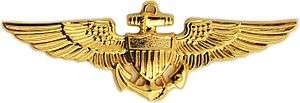 | |||
Foreign awards
King was also the recipient of several foreign awards and decorations (shown in order of acceptance and if more than one award for a country, placed in order of precedence):
| Grand Cross of the National Order of the Légion d'honneur (France) 1945 | |
| Croix de guerre (France) 1944 (attachment(s) unknown) | |
| Commander of the Order of Vasco Nunez de Balboa (Panama) 1929 | |
| Officer of the Order of the Crown of Italy 1933 | |
| Knight of the Grand Cross of the Military Order of Italy 1948 | |
| Order of Naval Merit (Brazil), Grand Officer 1943 | |
| Order of Naval Merit (Cuba) 1943 | |
| Estrella Abdon Calderon (Ecuador) 1943 | |
| Knight Grand Cross of the Order of the Bath (United Kingdom) 1945 | |
| Order of the Sacred Tripod (China) 1945 | |
| Grand Cross of the Order of George I (Greece) 1946 | |
| Grand Officer of the Order of the Crown (1948) | |
| Croix de Guerre (Belgium) (1948) (attachment(s) unknown) | |
| Knight Grand Cross with Swords of the Order of Orange-Nassau (Netherlands) 1948 |
Legacy
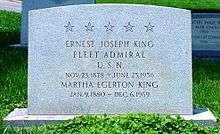
- The guided missile destroyer USS King was named in his honor.
- A major high school in his hometown of Lorain, Ohio, also bore his name (Admiral King High School) until it was merged with the city's other high school in 2010.
- In 2011, Lorain dedicated a Tribute Space at Admiral King's birthplace, and new elementary school in Lorain will bear his name.
- In 1956, schools located on the U.S. Naval Bases and Air Stations were given names of U.S. heroes of the past E.J. King High School, the Department of Defense high school on Sasebo Naval Base, in Japan, is named for him.
- The dining hall at the U.S. Naval Academy, King Hall, is named after him.
- The auditorium at the Naval Postgraduate School, King Hall, is also named after him.
- Recognizing King's great personal and professional interest in maritime history, the Secretary of the Navy named in his honor an academic chair at the Naval War College to be held with the title of the Ernest J. King Professor of Maritime History.
- King Drive at Arlington National Cemetery is named in honor of Fleet Admiral King.
- King Hall, the mess hall at the United States Naval Academy, is named in King's honor.
References
- ↑ U.S. officers holding five-star rank never retire; they draw full active duty pay for life.Spencer C. Tucker (2011). The Encyclopedia of the Vietnam War: A Political, Social, and Military History. ABC-CLIO. pp. 1685. ISBN 978-1-85109-961-0.
- ↑ Buell, Master of Sea Power, p. 3.
- ↑ Morison, The Battle of the Atlantic, p. 51.
- ↑ Buell, Master of Sea Power, 1980, pp. 10–12, 15–41.
- ↑ Martin Folly, Historical Dictionary of US Diplomacy
- ↑ Gannon, Operation Drumbeat, p. 168.
- ↑ "Full Text Citations For Award of The Navy Cross to Members of the US Navy World War I". Archived from the original on 2007-09-29.
- ↑ Young, Frank Pierce. "Pearl Harbor History: Building The Way To A Date Of Infamy". Retrieved 25 May 2013.
- ↑ Buell, Master of Sea Power, 1980, pp. 54–55.
- ↑ Buell, Master of Sea Power, 1980, p. 58.
- ↑ Buell, Master of Sea Power, 1980, pp. 62–64.
- ↑ King and Whitehill, A Naval Record, p. 187.
- ↑ King and Whitehill, A Naval Record, pp. 190–193.
- ↑ Huston, John W. (2002). Maj. Gen. John W. Huston, USAF, ed. American Airpower Comes of Age: General Henry H. "Hap" Arnold's World War II Diaries. Air University Press. p. 359. ISBN 1-58566-093-0.
- ↑ Buell, Master of Sea Power, p. 76.
- ↑ King and Whitehill, A Naval Record, p. 228.
- ↑ King and Whitehill, A Naval Record, p. 211.
- ↑ King and Whitehill, A Naval Record, p. 214.
- ↑ William H. Patterson, Robert A. Heinlein: A Learning Curve'
- ↑ King and Whitehill, A Naval Record, pp. 226–227.
- ↑ King and Whitehill, A Naval Record, pp. 240–242.
- ↑ King and Whitehill, A Naval Record, p. 249.
- ↑ King and Whitehill, A Naval Record, p. 266.
- ↑ King and Whitehill, A Naval Record, p. 279.
- ↑ Rebekah. "The Day that Will Live in Infamy ... but it didn't have to". The USS Flier Project. Retrieved 7 August 2012.
- ↑ King and Whitehill, A Naval Record, p. 295.
- ↑ https://www.ibiblio.org/hyperwar/USN/USNatWar/USN-King-1.html#III
- ↑ David B. Woolner, Warren F. Kimball, David Reynolds: FDR's World: War, Peace, and Legacies (Palgrave Macmillan, 2008), p.70.
- ↑ Timothy J. Ryan and Jan M. Copes To Die Gallantly – The Battle of the Atlantic, 1994 Westview Press, Chapter 7.
- ↑ Borneman. Page 463.
- 1 2 "Sea Classics. Mike Coppock. September 2007. ''ERNEST J. KING: WWII'S SALTIEST SEA DOG?'' page 5". Findarticles.com. Retrieved 2013-03-20.
- ↑ Gannon, Michael (1990). Operation Drumbeat. Harper. pp. 388–389 & 414–415. ISBN 0-06-092088-2.
- ↑ "Sea Classics. Mike Coppock. September 2007. ''Ernest J. King: WWII'S Saltiest Sea Dog?'' page 6". Findarticles.com. Retrieved 2013-03-20.
- ↑ Skates, John Ray (2000). The Invasion of Japan: Alternative to the Bomb. University of South Carolina Press. ISBN 0-87249-972-3.
- ↑ Buell, Master of Sea Power, 1980, p. 223.
- ↑ Buell, Master of Sea Power, 1980, p. 573.
- ↑ Heinl, Robert (1966). Dictionary of Military and Naval Quotations. Annapolis, MD: Naval Institute Press. p. 258. ISBN 0-87021-149-8.
- ↑ Clay Blair (2000). Hitler's U-Boat War: The Hunters, 1939–1942. Random House Digital, Inc. pp. 653–54.
- ↑ Graybar, Lloyd J. (1996). Quarterdeck and Bridge: Two Centuries of American Naval Leaders. Naval Institute Press. ISBN 1-55750-096-7.
- ↑ Morison, Samuel Eliot (1947). History of United States Naval Operations in World War II. Vol. I: The Battle of the Atlantic: 1939–1943. Little, Brown and Company. pp. 135–148. ISBN 0-316-58311-1.
- ↑ Gannon, Operation Drumbeat, 1990, pp. 391, 414–415.
- ↑ Buell ch 22
- ↑ Buell ch 30
- ↑ Lord Ismay, The Memoirs of General Lord Ismay (1974) p. 253
- ↑ Morison, Samuel Eliot (1957). History of United States Naval Operations in World War II. Vol. XI: Invasion of France & Germany: 1944–1945. Little, Brown and Company. pp. 13–14. ISBN 0-316-58311-1.
- ↑ Pogue, Forrest C. (1973). George C. Marshall: Organizer of Victory 1943–1945. Viking Adult. p. 305. ISBN 0-670-33694-7.
- ↑ Bowen, James. Despite Pearl Harbor, America adopts a 'Germany First' strategy. America Fights Back. The Pacific War from Pearl Harbor to Guadalcanal. Pacific War Historical Society. Archived from the original on 2007-09-29.
- ↑ Simkin, John. "Ernest King". Spartacus Educational. Archived from the original on 2007-12-29. Retrieved 2007-12-30.
- ↑ Gray, Anthony W., Jr. (1997). "Chapter 6: Joint Logistics in the Pacific Theater". In Alan Gropman. The Big 'L' — American Logistics in World War II. Washington, D.C.: National Defense University Press. Retrieved 2007-12-30.
- ↑ "Captain McVay". USS Indianapolis.org. Retrieved 2007-12-30.
- ↑ Buell, Master of Sea Power, 1980, pp. 12, 17, 26.
- ↑ Buell, Master of Sea Power, 1980, pp. 56, 452.
Bibliography
- Borneman, Walter R. (2012). The Admirals: Nimitz, Halsey, Leahy and King – The Five-Star Admirals Who Won the War at Sea (Hardback)
|format=requires|url=(help). New York: Little, Brown and Company. ISBN 978-0-316-09784-0. - Buell, Thomas B. (1995). Master of Sea Power: A Biography of Fleet Admiral Ernest J. King. Annapolis: Naval Institute Press. ISBN 1-55750-092-4.
- Gannon, Michael (1991). Operation Drumbeat. New York: Harper Collins. ISBN 0-06-092088-2.
- Jordan, Jonathan W. (2015), American Warlords: How Roosevelt's High Command Led America to Victory in World War II (NAL/Caliber 2015).
- King, Ernest; Whitehill, Walter Muir (1952). Fleet Admiral King: A Naval Record. New York City: W. W. Norton & Company. ISBN 0-7858-1302-0.
- Morison, Samuel Eliot (1947). Volume I. The Battle of the Atlantic, September 1939 – May 1943. History of United States Naval Operations in World War II. Boston: Little, Brown and Company. ISBN 0-7858-1302-0.
External links
| Wikiquote has quotations related to: Ernest King |
| Wikimedia Commons has media related to Ernest King. |
- "Fleet Admiral Ernest Joseph King". Naval Historical Center, Department of the Navy. 1 June 1996. Archived from the original on 29 December 2007. Retrieved 2007-12-30. Ernest King's biography on official U.S Department of the Navy website.
- O'Connor, Jerome (February 2004). "FDR's Undeclared War". Naval History magazine. U.S. Naval Institute. Archived from the original on 2007-12-19. Retrieved 2007-12-30. An article documenting the "sons of bitches" quote and other relevant facts.
- 24 Armed Trawlers of the RNPS 'Churchill's Pirate's' were sent to protect the US coast in 1942.
- Ernest J. King Papers 1897–1981 (bulk 1897–1953), MS 437 held by Special Collections & Archives, Nimitz Library at the United States Naval Academy
| Military offices | ||
|---|---|---|
| Preceded by Harold R. Stark |
Chief of Naval Operations 1942–1945 |
Succeeded by Chester W. Nimitz |
| Preceded by Husband Kimmel |
Commander in Chief United States Fleet 1941–1945 |
Succeeded by none |